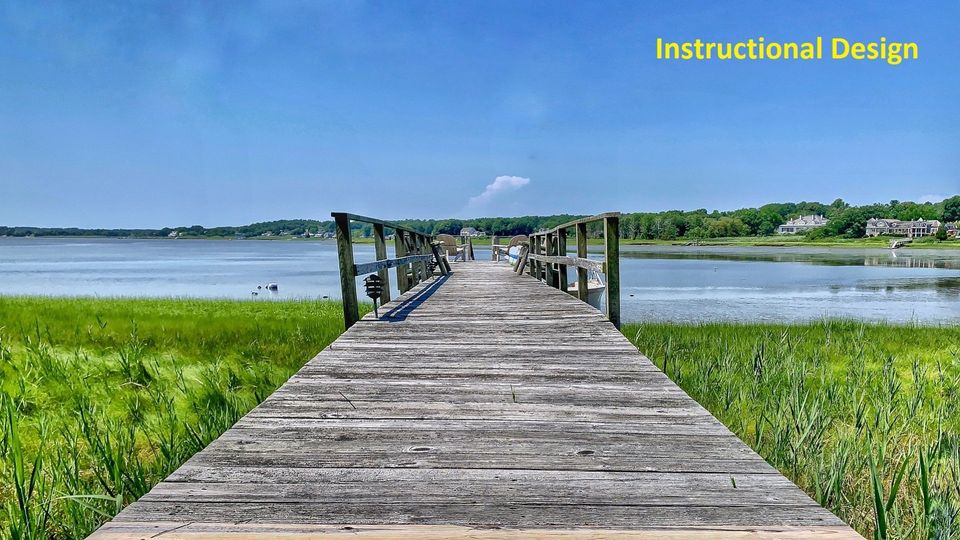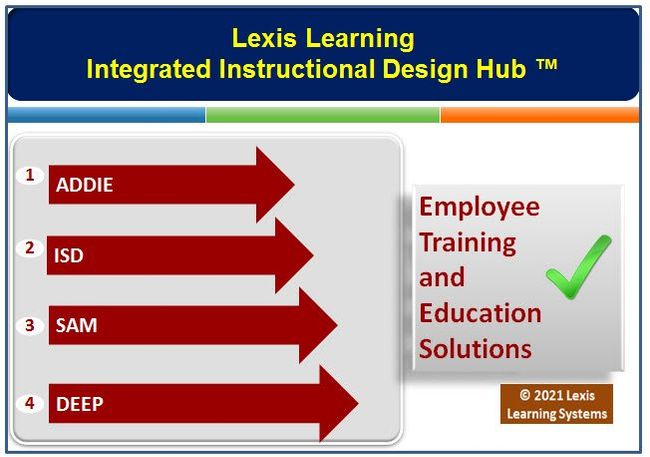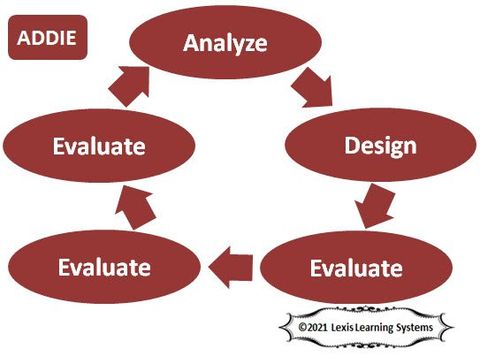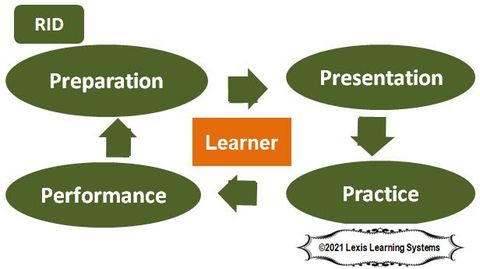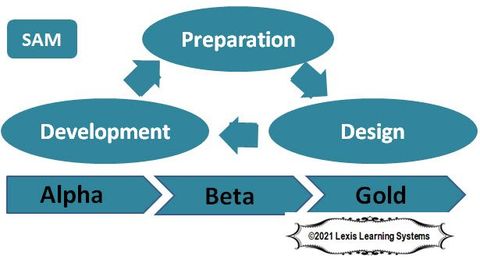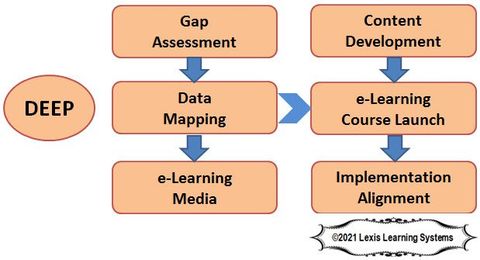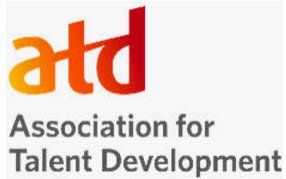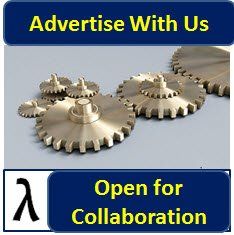Instructional Design
Standards for Instructional Design, Content Development and Delivery
We design, develop, and deliver impactful employee training and education solutions using multiple Instructional Content Development frameworks, based upon your organization’s learning needs and workforce performance improvement objectives.
Lexis Learning Instructional Design Hub™ is our content development workbench that includes ADDIE, RID, SAM, and DEED instructional design standards, outlined below:
Developed in 1975 by the University of Florida for the U.S. Army, ADDIE is an enduring model that seeks to capture and process the five fundamental steps of instructional Design: Analysis, Design, Development, Implementation and Evaluation.
Analysis: During the first phase, instructional needs are identified, learning objectives are tentatively outlined, and the development roadmap is established.
Design: A variety of concerns are addressed at this phase to achieve optimal courseware design and systematic development of the training program. They include more precise learning objectives, topics and flow of content, assessment instruments, exercises, subject matter analysis, lesson planning and the selection of instructional media. Each is pursued under a logical and orderly method of identifying, developing and evaluating plans for meeting instructional goals.
Development: The content is written according to the development roadmap. This process includes the design of storyboards and graphics, as well as integration of any e-Learning technologies.
Implementation: This phase focuses on developing procedures for training both facilitators and learners. For example, facilitators should be able to conduct training sessions. Learners should be able to use the new skills acquired during training. Instructional materials may include participant manuals, books, CD-ROMs, online training provided through a Learning Management System (LMS), and facilitator guides.
Evaluation: The evaluation phase is ongoing throughout the design process. Its purpose is to ensure that all stated goals of the development roadmap will meet the specified needs. Another objective of this phase is to identify on-the-job performance following completion of the course, and to ensure that business needs are met.
The Accelerated Learning Rapid Instructional Design (RID) model was developed in 2000 by David Meier, founder of the Center for Accelerated Learning. It is a concise learner-centered approach to content development that is composed of four interactive phases: Preparation, Presentation, Practice and Performance. Since its inception, RID has become the source for similar rapid development models.
Preparation:
Preparation is about preparing the learner for learning. In this first step, the instructor would discuss the overarching objectives of the training session and motivate learners to participate in the learning experience as contributors and collaborators.
Presentation:
At the presentation step, learners are not only exposed to the new knowledge or skill but also engage in relevant interactive activities and hands-on discovery learning.
Practice:
Practice involves having the learners use whatever they just learned, preferably in actual and real-world terms. By learning through trial-and-error, participants receive feedback on their progress towards mastery of the subject matter.
Performance:
Performance is the application of the new skill on the job, followed by authentic assessment that can take various forms, such as direct observation or the review of other types of performance results generated by the learner.
The Successive Approximation Model (SAM) provides an efficient and effective strategy for developing instructional content in building blocks. These iterations are intended to address some of the most common instructional design pain points, like meeting timelines, staying on budget and collaborating with Subject Matter Experts (SMEs).
SAM was developed by Allen Interactions and it consists of three iterations on the familiar instructional design steps:
** Preparation: Background and information gathering.
** Design: Prototype creation and review.
** Development and implementation of the training content moves through Alpha and Beta stages, until Gold Release,
which is followed by evaluation.
DYNAMIC E-LEARNING EVOLUTION PLATFORM
The Dynamic e-Learning Evolution Platform (DEEP) is a roadmap for developing an online course. This roadmap describes critical actions that are taken from the time that the need for virtual training has been identified to the time when a tangible e-Learning course has been created and released.
The Dynamic e-Learning Evolution Platform (DEEP)™ was created in 2010 by Lexis Learning Systems. This strategy focuses on e-Learning design and development. It guides instructional designers and training practitioners to view virtual training and learning as a concise, timely, methodical and synergistic process that is driven by Gap Assessment, Data Mapping, Media, Content Design, Launch, and Alignment.
1] E-Learning Gap Assessment: Development of a comprehensive training plan that provides the following fundamental
information:
*** The need for training.
*** Who needs to know what, why, when.
*** Tentative description of the e-Learning course.
2] E-Learning Data Mapping: During this stage, topic-relevant organizational knowledge is collected from SMEs, other
internal sources, and external providers. Key points to consider include:
*** Collection and organization of documented and unwritten information.
*** As needed, uise of surveys and focus groups that can provide useful input.
*** Mastery of the topic by the instructional designer and other training practitioners.
3] E-Learning Media: Selection and deployment of a Learning Management System that meets the training
requirements and the organization’s technical infrastructure and wider operational objectives. Additional factors
include:
*** The need for additional e-Learning options, such as podcasts, mobile learning or CD-ROM courseware,
*** Selection of interactive instructional design methods, such as animation, gamification, or virtual reality.
*** Integrating, learning and using appropriate instructional design applications and tools.
4] E-Learning Content Design: This phase is about the relatively rapid and outcomes-based approach to designing the
instructional content, with the following considerations;
*** The instructional design methodology (e.g. Mager,Cagne, or Bloom’s Taxonomy) and the instructional design
model (e.g. ADDIE, Accelerated Learning Rapid Instructional Design (RID), Successive Approximation Model (SAM) or
Dynamic e-Learning Evolution Platform (DEEP).
*** Integrating, learning and using appropriate instructional design applications and tools, such as Articulate or
Captivate.
*** Pilot-testing the content upon completion of each learning module.
5] E-Learning Product Launch: This is the strategy of making the e-Learning solution available to viewers, ideally within a
unified employee training portal. The release plan should outline a promotional campaign that seeks to inform
learners about the content. In addition:
*** Set up the course in the LMS to ensure easy access, usage, and tracking.
*** Explain the needs and benefits of this learning experience.
*** Describe how to access the e-Learning course.
6] E-Learning Implementation Alignment: The concluding course of action is to integrate the new e-Learning course into
existing processes in an effort to create value-adding organizational knowledge for the long term. These processes
may include:
*** Executive management support and advocacy.
*** Organizational Development initiatives.
*** New Employee Orientation programs.

